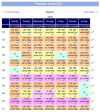Interest of a simple on-line screening registry for measuring ICU burden related to an influenza pandemic
- PMID: 22776231
- PMCID: PMC3580695
- DOI: 10.1186/cc11412
Interest of a simple on-line screening registry for measuring ICU burden related to an influenza pandemic
Abstract
Introduction: The specific burden imposed on Intensive Care Units (ICUs) during the A/H1N1 influenza 2009 pandemic has been poorly explored. An on-line screening registry allowed a daily report of ICU beds occupancy rate by flu infected patients (Flu-OR) admitted in French ICUs.
Methods: We conducted a prospective inception cohort study with results of an on-line screening registry designed for daily assessment of ICU burden.
Results: Among the 108 centers participating to the French H1N1 research network on mechanical ventilation (REVA) - French Society of Intensive Care (SRLF) registry, 69 ICUs belonging to seven large geographical areas voluntarily participated in a website screening-registry. The aim was to daily assess the ICU beds occupancy rate by influenza-infected and non-infected patients for at least three weeks. Three hundred ninety-one critically ill infected patients were enrolled in the cohort, representing a subset of 35% of the whole French 2009 pandemic cohort; 73% were mechanically ventilated, 13% required extra corporal membrane oxygenation (ECMO) and 22% died. The global Flu-OR in these ICUs was only 7.6%, but it exceeded a predefined 15% critical threshold in 32 ICUs for a total of 103 weeks. Flu-ORs were significantly higher in University than in non-University hospitals. The peak ICU burden was poorly predicted by observations obtained at the level of large geographical areas.
Conclusions: The peak Flu-OR during the pandemic significantly exceeded a 15% critical threshold in almost half of the ICUs, with an uneven distribution with time, geographical areas and between University and non-University hospitals. An on-line assessment of Flu-OR via a simple dedicated registry may contribute to better match resources and needs.
Figures




References
-
- Turbelin C, Pelat C, Boëlle PY, Lévy-Bruhl D, Carrat F, Blanchon T, Hanslik T. Early estimates of 2009 pandemic influenza A(H1N1) virus activity in general practice in France: incidence of influenza-like illness and age distribution of reported cases. Euro Surveill. 2009;14:pii:19341. - PubMed
-
- Fuhrman C, Bonmarin I, Bitar D, Cardoso T, Duport N, Herida M, Isnard H, Guidet B, Mimoz O, Richard JCM, Brun-Buisson C, Brochard L, Mailles A, Paty AC, Saura C, Lévy-Bruhl D. Adult intensive-care patients with 2009 pandemic influenza A(H1N1) infection. Epidemiol Infect. 2011;139:1202–1209. doi: 10.1017/S0950268810002414. - DOI - PubMed
-
- Jain S, Kamimoto L, Bramley AM, Schmitz AM, Benoit SR, Louie J, Sugerman DE, Druckenmiller JK, Ritger KA, Chugh R, Jasuja S, Deutscher M, Chen S, Walker JD, Duchin JS, Lett S, Soliva S, Wells EV, Swerdlow D, Uyeki TM, Fiore AE, Olsen SJ, Fry AM, Bridges CB, Finelli L. Hospitalized patients with 2009 H1N1 influenza in the United States, April-June 2009. N Engl J Med. 2009;361:1935–1944. doi: 10.1056/NEJMoa0906695. - DOI - PubMed
-
- Fowlkes AL, Arguin P, Biggerstaff MS, Gindler J, Blau D, Jain S, Dhara R, McLaughlin J, Turnipseed E, Meyer JJ, Louie JK, Siniscalchi A, Hamilton JJ, Reeves A, Park SY, Richter D, Ritchey MD, Cocoros NM, Blythe D, Peters S, Lynfield R, Peterson L, Anderson J, Moore Z, Williams R, McHugh L, Cruz C, Waters CL, Page SL, McDonald CK. et al.Epidemiology of 2009 pandemic influenza A(H1N1) deaths in the United States, April-July 2009. Clin Infect Dis. 2011;52(Suppl 1):S60–68. - PubMed
Publication types
MeSH terms
LinkOut - more resources
Full Text Sources
Medical

